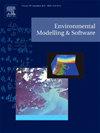Quantitative framework for soil burn severity from numerical wildfire models
IF 4.6
2区 环境科学与生态学
Q1 COMPUTER SCIENCE, INTERDISCIPLINARY APPLICATIONS
引用次数: 0
Abstract
Soil burn severity is a critical impact of wildfires. A numerical model of fire physics links heat flux and temperature to soil burn severity and follow-on hydrological effects. Numerical results for an example catchment-scale application demonstrate a high likelihood of severe burn for most of the region and the degree of soil alteration. The fire persists for an average of approximately 60 min for most of the area. Translation of peak heat fluxes to temperature showed that most of the soil in the fire scar was exposed to temperatures as high as 800–900 °C. The energy balance analysis revealed that soil moisture content decreases on average from 0.234 m3/m3 to 0.177 m3/m3 in the wildfire scar. The translation of peak heat flux into peak temperature and integration with Soil Organic Matter (SOM) shows that most near-surface SOM constituents are volatilized during the passage of the fire.
野火数值模型中土壤烧伤严重程度的定量框架
土壤烧伤严重程度是野火的关键影响因素。火灾物理的数值模型将热通量和温度与土壤烧伤严重程度和后续水文效应联系起来。一个流域尺度应用实例的数值结果表明,该地区大部分地区发生严重烧伤的可能性很高,土壤变化的程度也很高。在大部分地区,大火平均持续时间约为60分钟。峰值热通量与温度的转换表明,火坑内的大部分土壤暴露在800-900℃的高温下。能量平衡分析表明,林火毁伤区土壤含水量从0.234 m3/m3平均下降至0.177 m3/m3。将峰值热通量转化为峰值温度并与土壤有机质(SOM)积分表明,近地表SOM成分大部分在火灾过程中挥发。
本文章由计算机程序翻译,如有差异,请以英文原文为准。
求助全文
约1分钟内获得全文
求助全文
来源期刊

Environmental Modelling & Software
工程技术-工程:环境
CiteScore
9.30
自引率
8.20%
发文量
241
审稿时长
60 days
期刊介绍:
Environmental Modelling & Software publishes contributions, in the form of research articles, reviews and short communications, on recent advances in environmental modelling and/or software. The aim is to improve our capacity to represent, understand, predict or manage the behaviour of environmental systems at all practical scales, and to communicate those improvements to a wide scientific and professional audience.
 求助内容:
求助内容: 应助结果提醒方式:
应助结果提醒方式:


